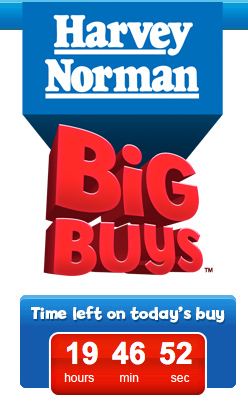Harvey Norman bets on cloud for Big Buys

Harvey Norman Big Buys CEO Kaine Escott revealed to ZDNet Australia at Tech.Ed today that the daily deals site had been designed for the cloud from its inception to deal with the peaking nature of the retail industry, and that having the site up was more important than its aesthetics.

Harvey Norman's Big Buys website
(Screenshot by Michael Lee/ZDNet Australia)
Escott said that when the idea for Big Buys started in late March to April, he was given a very short time frame of seven to eight weeks to provide Harvey Norman with an online presence in the daily deals market.
"There were no existing systems in the Harvey Norman group that could do what we needed to do, so we had to put a new back end in, which was Microsoft Dynamics NAV, and then bolt a website on to the front of that as well for the e-commerce," he said, adding that the Big Buys franchise brought on Hands-On as a partner to work through the process.
Using the Microsoft Azure platform, Big Buys could "dial up" extra servers to handle increases in peak traffic, which was a necessity due to the peaking nature of the retail industry.
"Retail's a volatile industry at the best of times and we were going to be a daily deals site. There were going to be some peaks and troughs in a daily sales cycle," he said. "Then we had to take into account [Harvey Norman CEO] Gerry [Harvey] and his impact on the media and what that would do to our volatility. The cloud seemed like a perfect solution for what we wanted to do and the problems we needed to solve."
Escott said that while cost was a consideration, and not having to spend huge amounts of money on infrastructure that would be sitting idle for most of the time was a definite benefit, the main reason for moving to the cloud was the flexibility to deal with those peaks.
However, when Harvey was scheduled to speak on Today Tonight and A Current Affair in response to an article in The Australian recently, Big Buys was able to use its set-up to bring another three servers online in anticipation for increased traffic.
"We normally run with about three instances in the cloud and they normally run at about 5 to 10 per cent. We normally do about 15,000 to 20,000 page views.
"At about 6:15pm that night, we decided to switch on three more instances in the cloud and at 6:30pm it went ballistic. We did 375,000 page views that night. That peaked at 80 [per cent] across six servers," said Escott.
"The three instances before that would have been trying to run at 160 [per cent] so we would have had ridiculously slow response times, but I think it would have crashed at that point. It wouldn't have been able to handle the load."
Escott said that if Big Buys hadn't been able to instantly double its capacity that evening, the business could have suffered. While he declined to name a financial value, he said the damage would have been substantial.
Escott said that personally, the Big Buys website had surpassed his expectations, although he did say that the expectations to begin with weren't definitive to begin with as no one knew what the market reaction would be.
"We are phenomenal retailers when it comes to providing an environment in a store format, that so-called magical buying environment, but you've got to learn that on the web," he said.
"We are a little unusual in that we're a very big company, but we didn't go out and hire six or 10 guys or steal them from Amazon — we took our own existing people and said, 'go and learn how to do that'."
Escott also said the site's aesthetics weren't as important than rapidly getting the site up and functional.
"You've seen the site, right? It's terrible, right? Here's the thing — I could have spent six months with designers and retail gurus coming up with the perfect design and you and I both know it wouldn't have been perfect," he said. "I'd rather get the thing out there in seven weeks and get all the feedback."
"[It's] the 80/20 rule of functionality — is there any point building that 80 per cent of functionality into a site if no one's going to use it?"
Although the site received a facelift today, Escott said he wasn't worried that the site's poor appearance would result in the loss of customers, saying that he always thought he could bring lost customers back.
"We will always get those people back because it will become too good not to try it again and then they'll come back and say, 'right, now it looks a bit better'."
The daily deals site is the result of Harvey's reluctant move online, which he thinks will net $1 billion within five to 10 years. When launching the site in April, he said that he had no choice but to "cannibalise" his stores, but according to Escott, the daily deals site makes it a point not to offer the same products online as in the retail stores.
Michael Lee travelled to Tech.Ed as a guest of Microsoft Australia.